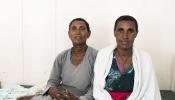A study published in Nature helped identify the mechanism that makes retinoblastoma – an eye tumour that is found in 5,000 children worldwide each year – so aggressive.
Retinal cells are generally slow to form. They take years or even decades to multiply, often going undetected. However, retinoblastoma is more like the sprinter than the marathon runner. This highly aggressive cancer develops at a devastating speed in children.
Researchers have long known that loss of a tumour suppressor gene named RB1 launches retinoblastoma during foetal development. But they didn’t know the other steps involved in the rapid transformation from a normal cell to a malignant tumour cell.
The most widespread theories held that the mutation of the RB1 gene affected chromosomes, causing multiple genetic mutations. Researchers have discovered, however, that these tumours contain very few mutations. The RB1 gene does not cause other genes involved in the tumour to mutate, but affects them, causing often reversible dysfunctions.
This discovery could lead to new treatments to cure retinoblastoma.
Source: http://www.sciencedaily.com/releases/2012/01/120113205452.htm
See also, Seva's blog post on 5-year-old Himal in Nepal and retinoblastoma.


